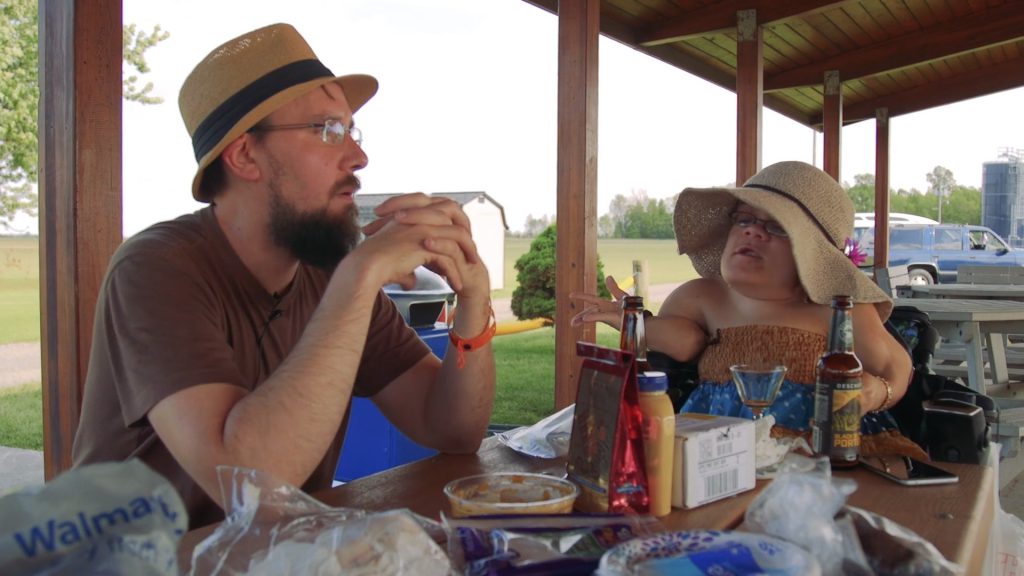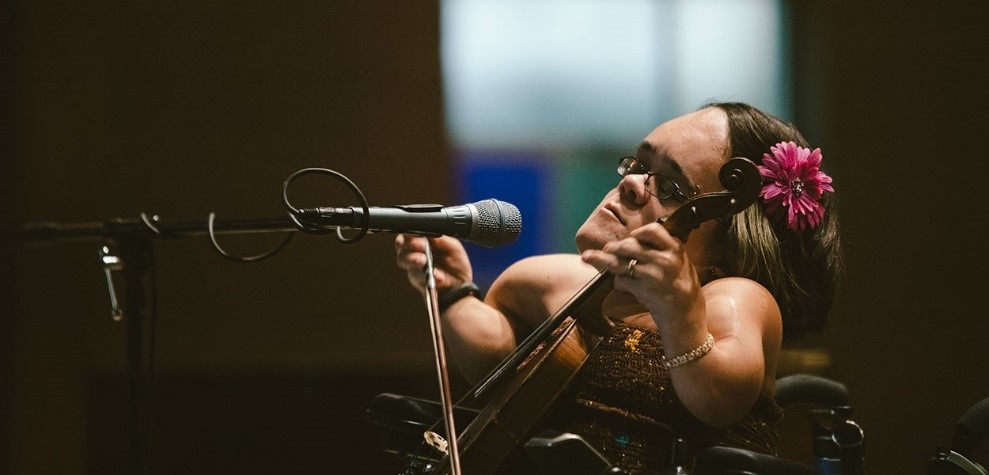Gaelynn Lea: The Songs We Sing (2017), directed by Mark Brown, focuses on Duluth-raised disability activist Gaelynn Lea as she travels the upper Midwest, singing and playing violin at different venues. Lea suffers from Brittle Bones Disease, which leaves her in a wheel chair. With this disease, playing an instrument should be quite difficult, but Lea improvises and uses her unique style to play the violin. The film highlights the struggles of living a different way, using documentary style filmmaking techniques to incorporates interviews and footage of Lea’s lifestyle. Gaelynn Lea may be a musician with a disability, but hers neither defines her nor stops her from doing what she loves.
The film starts out with extreme long shots of the surrounding areas of Duluth, Minnesota. These kinds of extreme long shots are usually associated with nature or adventure documentaries to display scenery in an atypical way; however, because Duluth is where Lea grew up and where she found her passion for music, here they also give the audience insight as to why Duluth is so important to her. The camera is connected to a drone for these shots, and the flying aspect while Lea talks over what the audience sees indicates how important her connection with nature is to her music and why she started playing in the first place. The director chose the first two shots to show the inaccessibility of nature for all people, but ends this shot sequence with the canal park area and lake walk that Duluth has tried to make accessible for all, including Gaelynn Lea.

Aerial drone shot of Duluth, Minnesota.

Aerial drone shot of Duluth, Minnesota.

Aerial drone shot of Duluth, Minnesota.
Mark Brown is a FAA certified drone pilot as well as a photographer, cinematographer, editor, and director. He used the shots shown above as well as others throughout the film to showcase his skills alongside Lea’s story and character. He runs Twin Town Media which made this film, and is also an independent documentary filmmaker with his skills in documentary helping create this short film.

Director and certified FAA drone operator Mark Brown.
The film utilizes talking heads for parts of the film, but unlike many documentary films, such as Thin Blue Line, which have their interviewees filmed sitting in a chair with a bland background behind them, Brown chooses more colorful backgrounds to keep the audience engaged. One shot in particular has Lea and her husband being interviewed at an outside restaurant. For the audience, this signifies the personal interaction between the camera and focal character. The camera acts as the eyes of a certain person, and because they are at a restaurant and not sitting on a chair getting questioned by the interviewer, it eases into a friendly conversation instead of an interview.

Gaelynn Lea and husband Paul.
This film could’ve centered around Lea simply being an inspiration for others–what Gaelynn called “Inspirational porn”–but director Mark Brown instead produced and directed a film that recognizes quitting your job and selling your house to go on tour would be hard for anyone, and Lea is just following her dreams. This concept of inspirational porn was an ethical question the director had to have been aware of. According to Bill Nichols in his book Introduction of Documentary, “value resides not in the ways in which [documentary subjects] disguise or transform their everyday behavior and personality but in the ways in which their everyday behavior and personality serve the needs of the filmmaker” (31). Paul and Lea didn’t want their story to showcase only her condition, but rather primarily focus on her music and what Lea has accomplished through it.

Gaelynn Lea performing with her violin.
Brown chose to have the “voice” of the film revealed through the background music. The audience hears a light violin playing in the background while Gaelynn Lea describes her love for music during the film, and the music played in the background coupled with shots of Gaelynn herself performing indicates to the audience that they are hearing Lea play. This allows the director to showcase the music and “voice” of the film through multiple mediums. Not only is Lea’s literal voice heard throughout the film with the use of voice-over narration, but when the audience is not hearing anyone speak and looking only at the motion picture, the music playing allows the entire film to include her musical voice. The soft violin playing throughout the film allows Lea’s love of music to seep through, not only diegetically, but nondiegetically as well. However, when the film reveals the busyness of her job and lifestyle, hip jazz tunes start to play and the storyline shifts from how music is important to Lea personally, to understanding how being a full-time musician works regardless of disability.
Gaelynn Lea: The Songs We Sing is a true representation of the artistic endeavors and triumphs of an artist who followed her dreams until they became reality. The film’s focus on music guides viewers throughout each sequence, literally soaring over the wilderness of Duluth with drones and focusing back in on the daily life of Lea and her family to create a documentary about so much more than disability.


Trackbacks/Pingbacks